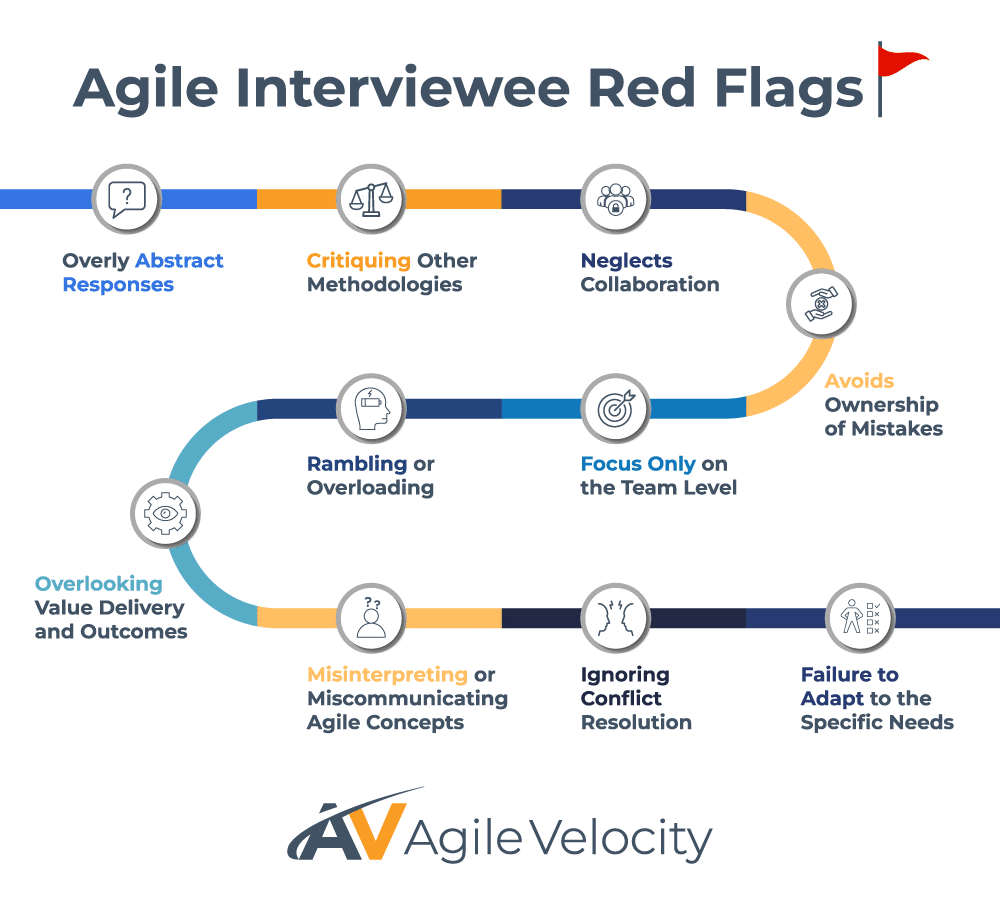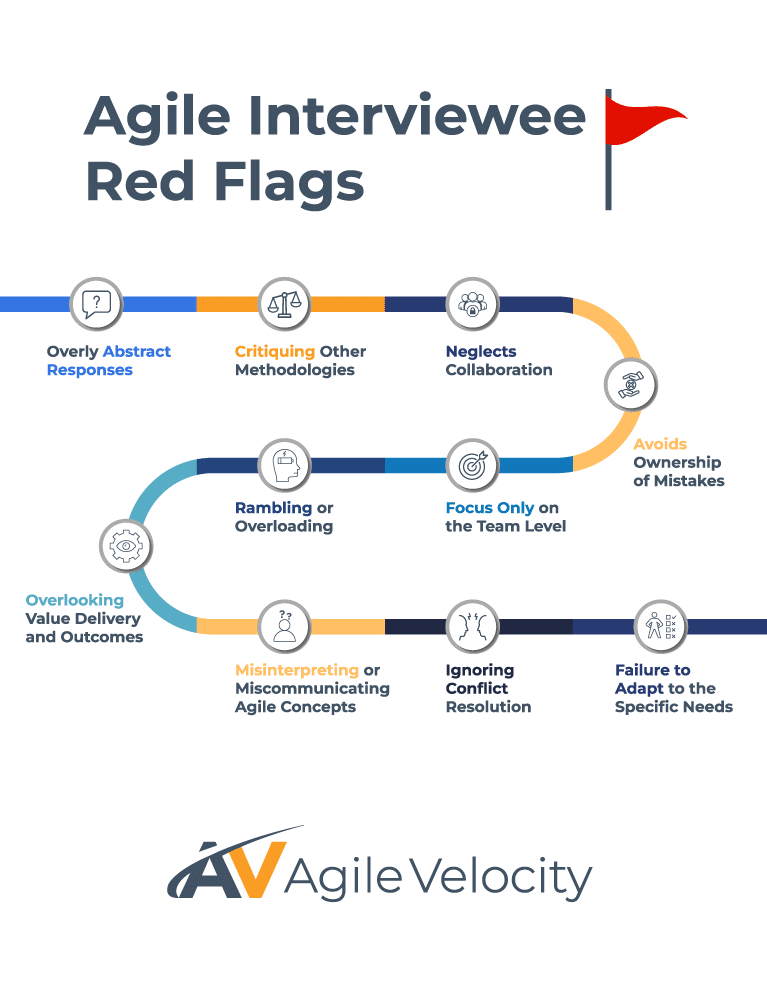As Agile practices continue to thrive across various industries, preparing for Agile-related interviews is essential for your organization’s growth. Whether you’re aiming to fill roles like Scrum Master, Product Owner, or Agile Coach, a solid grasp of Agile principles and frameworks can help you be better prepared. Agile interviews typically emphasize real-world applications, problem-solving skills, and fostering successful collaboration within dynamic environments.
This guide offers a comprehensive list of Agile interview questions tailored for different roles and frameworks. This will not only help you craft effective questions but also know what responses to look for in good candidates. Additionally, we’ll explore trends shaping Agile hiring in today’s business landscape, tips to avoid common pitfalls, and actionable advice to prepare both technical and behavioral inquiries.
Let’s jump in and get you ready to confidently interview candidates to determine who can best demonstrate their knowledge, adaptability, and passion for driving value through Agile!
Key Agile Interview Questions by Role
Preparing to interview candidates for specific Agile roles involves understanding each position’s responsibilities and effectively articulating the required experience. Below, we break down common interview questions for three in-demand Agile roles—Scrum Master, Product Owner, and Agile Coach—along with strategies to measure thoughtful responses.
Scrum Master Interview Questions
Scrum Masters foster collaboration, remove obstacles, and ensure adherence to Scrum principles. As an interviewer, you will need to assess candidates’ facilitation skills, conflict resolution approaches, and ability to maintain focus during Scrum events. Here are key questions to ask:
- How do you ensure the Daily Scrum remains productive and on-topic?
- Purpose: Evaluate facilitation skills and focus maintenance.
- Quality Response: A candidate who highlights timeboxing, encouraging focus on progress and impediments, and redirecting off-topic discussions to appropriate sessions.
- What steps do you take when your team over-commits to work during a Sprint?
- Purpose: Examine Sprint planning challenges and capacity issues.
- Quality Response: A candidate who can describe collaborating with the Product Owner to adjust the Sprint Backlog, coaching on realistic estimation, and reinforcing the value of delivering smaller, completed increments.
- How do you manage and resolve conflicts within the Scrum Team?
- Purpose: Assess conflict resolution skills and emotional intelligence.
- Quality Response: Someone who shares how they’ve created a safe environment for open communication, encouraging constructive dialogue to address root causes, and using coaching techniques to guide the team toward mutually beneficial outcomes.
- What would you do if a stakeholder repeatedly requests changes midway through a Sprint?
- Purpose: Test ability to balance responsiveness with maintaining team focus.
- Quality Response: A candidate who emphasizes collaboration with the Product Owner to assess urgency, adjust Sprint scope if necessary, or defer changes to upcoming Sprints while ensuring alignment with the Sprint Goal.
- How do you measure your effectiveness as a Scrum Master?
- Purpose: Gauge awareness of key success metrics.
- Quality Response: Look for a response that references metrics like team morale, reduced impediments, consistent delivery of usable increments, and improvements in team collaboration and adaptability.
Product Owner Interview Questions
Product Owners maximize product value, manage the Product Backlog, and set clear priorities. Common interview questions should focus on defining vision, managing competing demands, and delivering measurable outcomes.
- How do you build and refine a strong Product Backlog?
- Purpose: Assess ability to prioritize and align the backlog with business objectives.
- Quality Response: A candidate who discusses ongoing collaboration with stakeholders, using prioritization models, and backlog grooming to ensure well-defined, high-value items for upcoming Sprints.
- What methods do you use to balance short-term needs with long-term product goals?
- Purpose: Explore managing urgent demands, technical debt, and strategic objectives.
- Quality Response: A response that shares thoughts on assessing the cost of delay, incorporating customer feedback, and balancing quick fixes with long-term priorities through constant backlog reassessment.
- How do you handle conflicting priorities from multiple stakeholders?
- Purpose: Evaluate stakeholder management and negotiation skills.
- Quality Response: Look for an answer that illustrates using business value metrics, data, or customer feedback to make informed decisions. Ask them to describe their approaches to communicating trade-offs and ensuring all parties understand prioritization rationales.
- What metrics do you use to evaluate the success of a product or feature?
- Purpose: Test understanding of value-driven outcomes and product success indicators.
- Quality Response: A response that mentions KPIs like customer satisfaction (CSAT), adoption rates, revenue growth, and efficiency improvements. Then ask them to explain how these metrics inform future refinements.
- What would you do if development consistently failed to meet Sprint Goals?
- Purpose: Assess problem-solving ability in balancing team capacity and strategic goals.
- Quality Response: Look for a candidate who discusses collaboration with the Scrum Master and development team to uncover root issues, fostering better transparency and alignment during Sprint Planning.
Build High-Performing Teams
Agile Coach Interview Questions
Agile Coaches embed Agile practices, enable cultural change, and drive scalability within organizations. Interview questions need to focus on mentoring leaders, facilitating large-scale transformations, and resolving resistance to change.
- How do you engage leadership teams that are new to Agile?
- Purpose: Assess how you educate and align leadership on Agile principles.
- Quality Response: A great candidate will be one who can provide examples of running workshops, connecting Agile practices to organizational outcomes, and guiding leaders in modeling behavior that aligns with Agile values.
- What is your approach when a team or manager resists Agile practices?
- Purpose: Evaluate handling cultural resistance during an Agile Transformation.
- Quality Response: Look for an emphasis on empathy, patience, and identifying root causes of resistance. Look for a candidate who explains how highlighting small wins and tangible benefits can foster gradual buy-in to Agile practices.
- How do you support scaling Agile practices across teams of varying maturity?
- Purpose: Determine knowledge of scaling frameworks and coaching approaches.
- Quality Response: A quality candidate may be able to discuss using tailored strategies, such as frameworks like SAFe or Large-Scale Scrum (LeSS), while reinforcing team-level Agile fundamentals. Ask them to share examples of how they have or would help each team advance at their own pace.
- How do you measure the success of an Agile Transformation?
- Purpose: Evaluate understanding of effective transformation metrics.
- Quality Response: Look for respondents that can reference both qualitative and quantitative indicators, such as faster time-to-market, improved team predictability, enhanced customer satisfaction, and shifts in team collaboration and culture.
- What steps do you take to sustain an Agile culture in the long term?
- Purpose: Ensure strategies for ongoing adoption and cultural embedding.
- Quality Response: A good candidate may discuss creating internal communities of practice, providing ongoing training, and building leadership support to keep Agile principles alive. Ask interviewees to share strategies for reinforcing continuous learning and adaptation.
General Agile Knowledge Interview Questions

A solid understanding of Agile principles, values, and methodologies is essential for any Agile-related role. These foundational questions will test your interviewees grasp of core concepts and application in real-world scenarios.
- What are the core values and principles of Agile, and how do they influence team behavior?
- Purpose: Evaluate understanding of the Agile Manifesto and its impact on team dynamics.
- Quality Response: A fantastic response will be one that references the four core values—individuals and interactions, working product, customer collaboration, and responsiveness to change. Ask candidates to elaborate on how these principles foster collaboration, adaptability, and value delivery, using examples like improving team communication or embracing iterative feedback.
- How do incremental delivery and iterative improvement differ, and why are they important in Agile?
- Purpose: Test ability to distinguish between and apply two key Agile concepts.
- Quality Response: Responses should explain that incremental delivery focuses on delivering smaller, functional pieces of a product, while iterative improvement involves refining those pieces based on feedback. A great response will emphasize how both approaches reduce risk and shorten time-to-value, with examples like delivering an MVP or fine-tuning features post-release.
- How does an Agile team handle changing requirements while maintaining productivity?
- Purpose: Assess understanding of Agile’s flexibility in managing evolving requirements.
- Quality Response: A great candidate will discuss adopting a flexible mindset, maintaining a prioritized Product Backlog, and using iterative cycles to incorporate changes without disrupting overall productivity. Ask respondents to provide examples of accommodating changes mid-Sprint through effective communication and backlog management.
- How do you build a Minimum Viable Product (MVP) and Minimal Marketable Product (MMP)? What is the difference between them?
- Purpose: Evaluate knowledge of Agile product development strategies.
- Quality Response: First, a candidate should define MVP as the simplest version of a product used to validate assumptions and gather feedback, while MMP focuses on delivering a fully functional product that satisfies early customers and can be marketed. If accurately described, ask them to provide an example, such as using an MVP for market testing and evolving into an MMP for broader adoption.
- How does Agile approach risk management differently than traditional project management methods?
- Purpose: Identify understanding of Agile’s proactive risk mitigation.
- Quality Response: Look for a candidate that can explain that Agile incorporates risk management as a continuous, integral process rather than a one-time planning activity. Their answer should highlight how frequent feedback loops, incremental deliveries, and prioritized backlogs facilitate early identification and mitigation of risks. Consider asking them to provide an example, such as adapting quickly to new customer needs during a Sprint.
- What are some common misconceptions about Agile, and how would you address them?
- Purpose: Evaluate ability to clarify Agile practices and advocate for their proper use.
- Quality Response: The answer should address misconceptions like “Agile doesn’t require planning” or “Agile eliminates deadlines.” They should be able to counter these myths by explaining Agile’s disciplined practices such as Sprint Planning and timeboxing. An experienced candidate will likely use personal experience examples to clarify Agile’s balance between adaptability and structure.
To effectively navigate the responses for these Agile knowledge questions, look for candidates who give clear and concise explanations backed by real-world examples. Those who can demonstrate both theoretical understanding and practical application of these concepts to deliver results, showcase Agile values like collaboration, transparency, and adaptability.
Behavioral and Scenario-Based Agile Interview Questions

Demonstrating how well candidates apply Agile principles in real-world situations is crucial. As the employer, you should use behavioral and scenario-based questions to gauge problem-solving and collaboration skills, as well as adaptability in dynamic environments. Below are common scenarios you might consider for interviews, along with what to look for in effective responses:
Example Scenarios and How to Approach Them
- Scenario: A team member regularly fails to complete tasks during Sprints. How do you handle this?
- Purpose: Evaluate ability to address individual performance issues while maintaining team cohesion.
- Quality Response: Look for a candidate that highlights commitment to understanding the root cause through open communication. Ask them to describe scheduling a one-on-one to identify obstacles—whether related to skill gaps, unclear expectations, or external distractions. A quality response will emphasize fostering a supportive environment where the Scrum Team works together to encourage accountability and improve collaboration.
- Scenario: Leadership reports inconsistent results during a multi-team Agile Transformation because many teams are hesitant to adopt new ways of working. How do you address this?
- Purpose: Assess ability to manage resistance and align teams with organizational goals during large-scale change.
- Quality Response: Look for someone who suggests re-engaging leadership to act as Agile Transformation champions, emphasizing long-term value. Ask them to outline steps like hosting tailored workshops for resistant teams, creating a roadmap aligning with their needs, and celebrating small wins to build momentum.
- Scenario: Stakeholders complain that Sprint Reviews feel like routine demos, with little meaningful feedback or engagement. How would you improve these sessions?
- Purpose: Evaluate ability to make Scrum events productive and engaging.
- Quality Response: A great respondent will discuss how they would prepare stakeholders before the event, ensuring they understand their role in providing actionable feedback. A great answer will highlight encouraging the Scrum Team to showcase tangible product increments while facilitating open discussions on outcomes, obstacles, and next steps.
- Scenario: A newly formed team struggles with cohesion as they are tasked with adapting to either fully remote work or frequent in-office return-to-work events. How do you maintain collaboration and productivity in this environment?
- Purpose: Test adaptability in managing hybrid or distributed teams.
- Quality Response: A candidate that suggests establishing clear working agreements based on team input to ensure alignment on expectations, regardless of the work model. Likewise, a response that highlights tools and practices that foster transparency and collaboration, such as Digital Kanban Boards or scheduled retrospectives.
Key Things to Look for In Respondents Answers to Behavioral Questions
Look for an interview who:
- Uses of the STAR Method: Structures answers around Situation, Task, Action, and Result for clarity and conciseness.
- Share Real-World Examples: Highlights experiences by demonstrating application of Agile principles.
- Uses Relevant Terminology Thoughtfully: Integrates Agile terminology appropriately to demonstrate familiarity while keeping explanations clear.
- Emphasizes Collaboration and Adaptability: Shows how they’ve worked with cross-functional stakeholders and facilitated alignment within a Scrum Team.
- Showcases Emotional Intelligence: Emphasizes empathy and understanding in conflict or resistance scenarios.
- Leverages Agile Values: Grounds answers in Agile principles like collaboration, customer focus, transparency, and responsiveness to feedback.
- Communicates Results Clearly: Connects actions to measurable outcomes, such as reduced cycle times or increased team satisfaction.
- Practices Active Listening: Tailors responses to address exactly what’s being asked by paying close attention to question phrasing.
- Is prepared for Questions About Mistakes: Shares how they identified issues, made adjustments, and improved processes to show a growth mindset.
Overall, look for a candidate who answers behavioral questions with confidence and sincerity. These are the ones who are positioning themselves as a candidate who not only understands Agile but lives its principles, solving problems with a balance of strategy, empathy, and collaboration.
Red Flags to Look for During Agile Interviews
Even well-prepared candidates can stumble during Agile interviews. Here are common things to look for:


- Overly Abstract Responses: Better answers are those that focus on concrete examples tied to specific experiences.
- Critiquing Other Methodologies Without Balance: A quality candidate should highlight Agile strengths without dismissing traditional methods entirely.
- Neglects Communication and Collaboration: Ensure answers reflect the ability to engage stakeholders and work cohesively with teams.
- Avoids Ownership of Mistakes: Candidates should be able to share how they’ve learned from errors and improved processes, demonstrating self-awareness and adaptability.
- Focusing Only on the Team Level: Answers should also address how they themselves have worked across teams or departments to drive Agile Transformations on a larger scale.
- Rambling or Overloading with Details: Candidates should be keeping responses concise and structured to maintain your interest.
- Overlooking Value Delivery and Outcomes: Good interview question responses will connect actions to measurable business outcomes to demonstrating impact.
- Misinterpreting or Miscommunicating Agile Concepts: Ensure that the candidates are accurately explaining Agile principles, frameworks, and terminology.
- Ignoring Constructive Conflict Resolution: Look for candidates that share how they’ve effectively managed resistance and resolved conflicts constructively.
- Failure to Adapt to the Organization’s Specific Needs: Answers should be tailored to reflect the unique challenges and context of your organization.
Look for candidates who showcase problem-solving and leadership skills aligning with Agile values, and integrate outcomes and collaboration into every response. Self-awareness, curiosity, and a continuous improvement mindset are key traits to look for in interviewees.
Emerging Trends in Agile Hiring
The Agile hiring landscape is evolving in response to shifting workplace dynamics, technological advancements, and the growing need for enterprise-level agility. As organizations adapt to rapid market changes, they seek Agile professionals who bring both technical expertise and the ability to navigate new challenges. Key trends shaping Agile hiring include:
Thriving in Hybrid and Remote Work Environments
Agile teams need to work well together, even in different environments. As the employer, look for candidates who can build cohesive teams, facilitate meaningful collaboration in virtual settings, and leverage in-person events like team-building sessions or strategy days to strengthen alignment. Proficiency with tools like Digital Kanban Boards, video conferencing platforms, and asynchronous communication workflows is increasingly valuable.
Emphasis on AI-Driven Agile Practices
Artificial intelligence is transforming Agile workflows, enabling smarter backlog prioritization, effort estimation, and capacity planning. Professionals with experience in leveraging AI-based tools to streamline Agile practices will stand out. Look for candidates who can discuss how AI integrates with frameworks like Scrum or SAFe or who demonstrate forward-thinking skills and the ability to adapt.
The Rise of Organizational Agility
Companies are focusing on agility at the enterprise level, beyond team-level implementations. Agile professionals with experience in scaling frameworks like SAFe, Lean Portfolio Management, or business agility coaching are in high demand. Candidates connecting Agile principles to measurable business outcomes, improving cross-team alignment, and enabling strategic adaptability are vital in these transformations.
Agile Roles During Critical Transformation Periods
Organizations are increasingly utilizing external Agile Coaches, Scrum Masters, or Portfolio Managers during significant transformation periods. Professionals comfortable with short-term or project-based engagements, delivering value rapidly, and fostering collaboration will thrive in this trend.
Prioritizing Continuous Learning and Adaptability
Employers value individuals with a growth mindset—actively pursuing certifications, staying updated on new frameworks, and embracing evolving Agile practices. Evidence of ongoing learning, such as recent training in specialized topics or frameworks positions candidates as forward-thinking and prepared for future challenges.
Agile hiring reflects the growing complexity of organizational environments and the need for professionals who combine technical expertise with a strategic, adaptable approach. Candidates demonstrating versatility in collaboration, technology integration, and enterprise-level agility will have a clear edge in this competitive landscape.
Ready to Find the Right Candidate for Your Organization?

Preparing to give Agile interviews doesn’t have to be overwhelming. With the right preparation you can confidently tackle any responses, or questions from the candidates that come your way. This guide has covered a variety of potential interview topics—from role-specific inquiries to framework-focused and behavioral questions—ensuring you’re equipped with the right questions to find the best fit for your organization.
Remember, concise, thoughtful answers highlighting adaptability, collaboration, and results-driven mindset are things that set candidates apart. Agile interviews aren’t just about theory; they’re about demonstrating how the interviewees apply Agile practices to drive value and foster team success. Use the strategies outlined here to craft great interview questions that will extract expertise and commitment to continuous learning.
If you need help finding people with the right mindset, skills, and vision to thrive in the Agile roles you’re hiring for, consider reaching out to Agile Velocity. Agile Velocity’s Agile Staffing services are expertly designed to help organizations find the right talent for specific Agile roles, such as the roles discussed in this blog. By leveraging a deep understanding of Agile principles and industry trends, Agile Velocity ensures that candidates are not only technically proficient but also embody essential Agile mindsets, such as adaptability, collaboration, and value-driven goals.
Contact Agile Velocity today and learn how they can help you find the right teammates that match the unique needs of your organizations.



